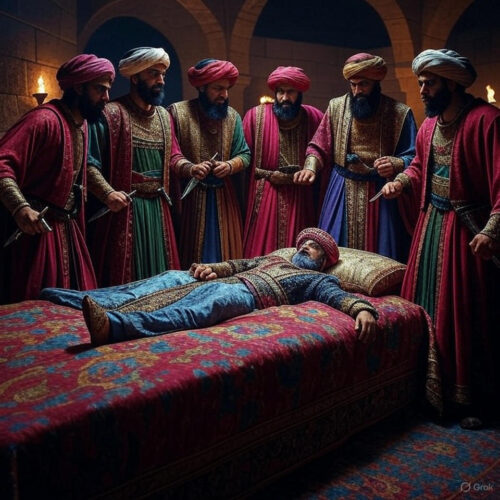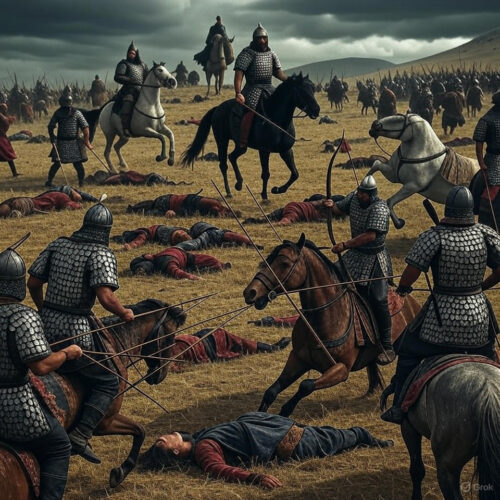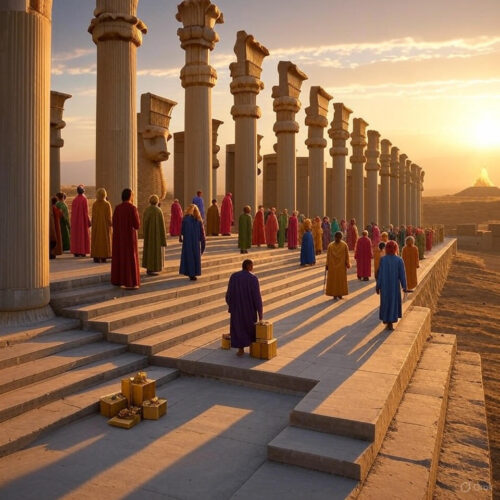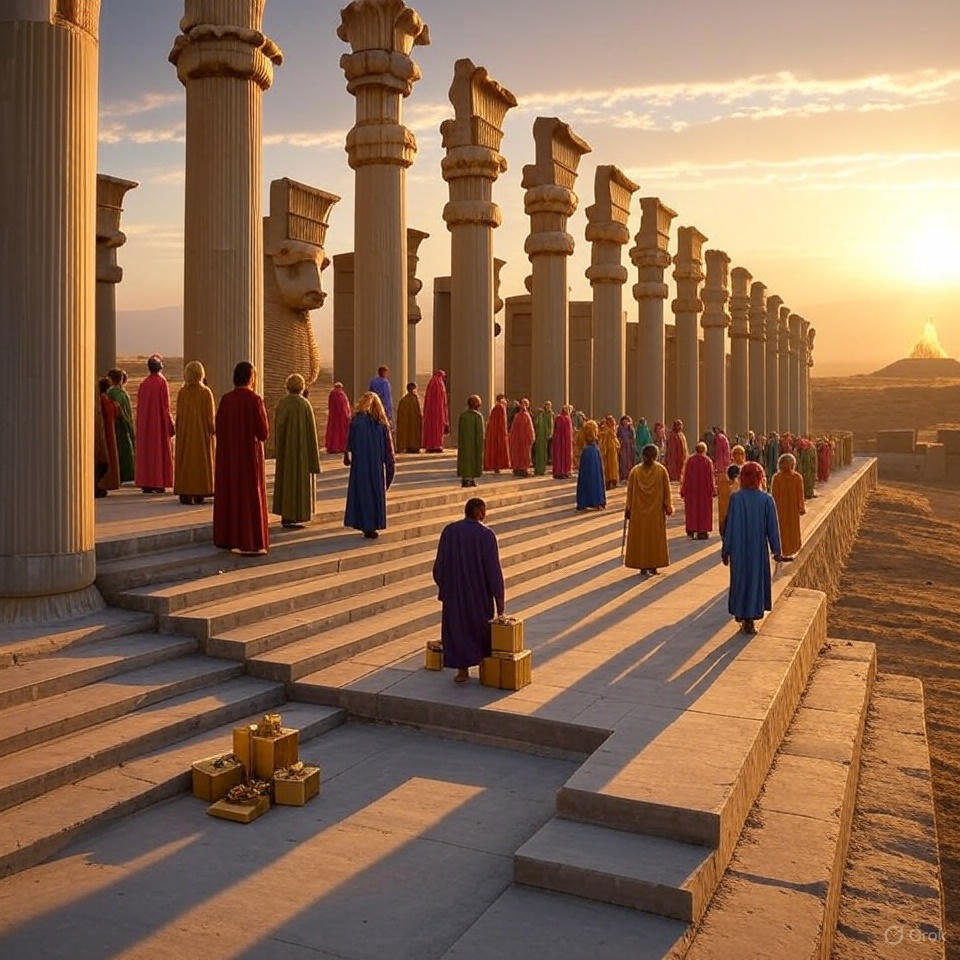Imagine a moonless night in ancient Media, the air thick with the scent of dust and intrigue. A fortress looms like a silent sentinel, its walls echoing with the whispers of guards who suspect nothing. Inside, a false king sleeps, his dreams woven from the threads of a lie that has toppled an empire. Outside, seven shadows move—nobles cloaked in determination, daggers glinting under starlight. On September 29, 522 BC, these men would strike, their blades ending a usurpation that threatened to unravel the greatest realm the world had ever known. This was no mere assassination; it was the birth pangs of a golden age, forged in the fires of betrayal and ambition. The man at the heart of it? Darius, a young warrior whose name would echo through millennia as Darius the Great.
This tale isn’t just a dusty footnote in history books—it’s a pulse-pounding saga of deception, divine intervention (or so the victor claimed), and unyielding resolve. We’ll dive deep into the labyrinthine politics of the Achaemenid Empire, uncovering the web of lies spun by a Magian priest named Gaumata, the desperate conspiracy of seven Persian elites, and the whirlwind of wars that followed. By the time we’re done, you’ll see how one fateful autumn day reshaped the ancient world, from the sun-baked plains of Persia to the Nile’s fertile banks. And yes, we’ll peek at how that ancient audacity can ignite your own path today—but first, let’s unearth the bones of the story, layer by gritty layer.
### The Foundations of an Empire: Cyrus and the Dawn of Achaemenid Glory
To grasp the chaos of 522 BC, we must rewind to the empire’s cradle. The Achaemenid dynasty didn’t spring from nowhere; it was hammered on the anvil of conquest by Cyrus the Great, a visionary king whose life reads like an epic poem. Born around 600 BC in Anshan, a rugged region in what is now southwestern Iran, Cyrus II inherited a modest Median vassal kingdom. But he was no timid ruler. In 559 BC, he ascended the throne, and within a decade, he flipped the script on his overlords.
Picture this: The Medes, under the iron-fisted Astyages, had long dominated the Persians. But Cyrus, blending shrewd diplomacy with lightning warfare, rebelled in 553 BC. By 550 BC, he’d stormed the Median capital of Ecbatana (modern Hamadan), toppling Astyages and absorbing Media into his realm. This wasn’t brute force alone—Cyrus was a master propagandist. His famous Cyrus Cylinder, unearthed in Babylon in 1879, proclaims him as a liberator chosen by Marduk, the Babylonian god, to free the oppressed. When he sacked Babylon in 539 BC without a siege—by diverting the Euphrates and slipping under the walls—he freed captives, restored temples, and welcomed exiles. Jews, in particular, hailed him as a messiah in the Bible’s Book of Isaiah.
Cyrus’s empire stretched from the Indus Valley in the east to Anatolia in the west, a staggering 5.5 million square kilometers. He organized it into satrapies—provinces governed by loyal nobles—with a network of royal roads that buzzed with couriers on horseback, covering 2,500 kilometers in seven days. Taxes flowed like rivers: silver talents from Babylonia, gold darics from Lydia. But Cyrus met his end in 530 BC, slain in a skirmish against the nomadic Massagetae in Central Asia. His tomb at Pasargadae, a simple stone gabled structure amid gardens, stands today as a testament to his humility amid grandeur.
Enter his son, Cambyses II. Crowned co-ruler in 553 BC but sole king after Cyrus’s death, Cambyses was a chip off the old block—ruthless, expansionist, but shadowed by paranoia. His crowning achievement? The conquest of Egypt in 525 BC. After years of probing Nubia and probing alliances, Cambyses launched a massive invasion. His fleet of Phoenician ships hugged the coast while his army marched across Sinai’s scorching sands. At Pelusium, the gateway to the Nile Delta, the Persians unleashed psychological warfare: cats, sacred to Egyptians, were painted on shields and released amid the ranks, sowing hesitation. Psamtik III, the last pharaoh, fell after a brutal siege. Cambyses declared himself Pharaoh Neferibe, but his rule soured fast. Stories swirl of him desecrating Egyptian gods—slaughtering Apis bulls, mocking sacred rites—fueling resentment. Herodotus, the Greek historian writing a century later, paints Cambyses as a mad tyrant, stabbing the Apis calf in a fit of rage. True or exaggerated? We’ll never know, but it set a toxic tone.
Cambyses’s personal life was a tragedy. He had a full brother, Bardiya (or Smerdis in Greek), born of the same noble stock. But whispers of fratricide haunted him. According to Darius’s later propaganda, Cambyses secretly murdered Bardiya before his Egyptian campaign to eliminate a rival. Herodotus concurs, saying Cambyses ordered Prexaspes, a trusted courtier, to do the deed—luring Bardiya to a remote hunt and shooting him with an arrow, then burying him in secret. The Persian people, far from the court, remained ignorant. Cambyses pressed on, but misfortune dogged him: a lion killed his sacred falcon, omens turned sour, and in 522 BC, while marching back from Egypt, he died. Official tale? A self-inflicted wound from falling on his sword. Coincidence? Or cover for assassination? The empire teetered.
### The Magian’s Masquerade: Gaumata’s Audacious Deception
Into this vacuum slithered Gaumata, a figure as enigmatic as he was opportunistic. A Magus—a priest of Zoroastrianism’s ancient faith, versed in rituals, astrology, and whispers of the unseen—Gaumata hailed from the mountains of Media. The Magi were no footnotes; they were the empire’s spiritual backbone, interpreting omens and anointing kings. But power corrupts, and Gaumata saw his chance.
On March 11, 522 BC, as Cambyses languished in Egypt, Gaumata ignited rebellion in Paishiyauvada, a distant Persian district. His claim? He was Bardiya, the slain prince, risen to reclaim his birthright. Why did it stick? Physical resemblance—both were said to have ears that didn’t lobe like typical Persians (a royal trait?)—and the secret of Bardiya’s death. The common folk, burdened by Cambyses’s heavy taxes and Egyptian levies, rallied. “The false Bardiya” abolished conscript labor on royal canals, remitted debts, and promised relief. By April, Media and Persia had flipped. When news of Cambyses’s death hit in July, Gaumata’s grip tightened. He moved the court to Pasargadae, Cyrus’s old capital, and ruled as “Bardiya II.”
But cracks appeared. Nobles close to the court grew suspicious. Otanes, a high-ranking Persian whose daughter Cambyses had wed (and later divorced in a fit of jealousy), caught wind of the imposture. How? Legend says his daughter, locked in Gaumata’s harem, noticed the pretender’s ears didn’t match Bardiya’s—unlobed, a Magian mark. Or perhaps it was ritual knowledge: Gaumata skipped Zoroastrian sacrifices, favoring Magian fire rites. Otanes tested the waters, confiding in Aspathines, then Intaphernes, Gobryas, Hydarnes, and Megabyzus—six pillars of the old guard. Enter Darius, the wildcard.
Darius son of Hystaspes was no Achaemenid by direct blood—his lineage traced to Teispes, a collateral branch—but his father governed Bactria, and he’d served as Cambyses’s spear-bearer in Egypt. At 28, Darius was ambitious, battle-hardened, and devout. In Susa, the plot crystallized. The seven swore oaths over a bull’s entrails, vowing secrecy. Failure meant death; success, the throne. Herodotus adds flair: they debated governance—democracy? Oligarchy?—but Darius, ever the monarchist, argued for one king to bind the fractious empire. To decide the leader, a horse test: whose stallion neighed first at dawn would rule. Darius’s groom, Oebares, rigged it with a mare’s cunning ploy, ensuring victory. Thunder rumbled—Ahuramazda’s nod, they claimed.
Gaumata, meanwhile, consolidated. He razed temples, seized lands, and executed suspects. His seven-month reign (March to September 522 BC) was a whirlwind of reform and terror. Elam, Babylon, and Armenia stirred with unrest, sensing weakness. The pretender’s folly? Isolating himself in the fortified Sikayauvati in Nisaea, a lush plain near Ecbatana, ringed by mountains and the many-named river (the modern Qareh Su).
### The Night of Blades: September 29, 522 BC
Dawn was hours away when the conspirators struck. The Behistun Inscription, Darius’s rock-carved manifesto chiseled into a cliff near Kermanshah in 520 BC, recounts it starkly: “Then I prayed to Ahuramazda; Ahuramazda brought me help. On the tenth day of the month Bagayadiš (29 September 522), I, with a few men, slew that Gaumâta, the Magian, and the chief men who were his followers. A fortress called Sikayauvatiš in the district of Nisâya in Media—this is where Gaumâta the Magian was. I slew him; I took the kingdom away from him. By the grace of Ahuramazda, I became king.”
Details flesh out the drama. The seven scaled the fortress walls under cover of night, perhaps bribing guards or using insider knowledge from harem spies. No grand battle—just a surge into the bedchamber. Gaumata awoke to steel. Darius, per tradition, delivered the fatal thrust, his dagger piercing the usurper’s throat. Followers were dragged out and butchered; heads rolled into the dust. By morning, the plotters proclaimed Darius king from the fortress battlements. The people, relieved by the “restoration” of order, acclaimed him—though whispers of Bardiya’s true identity lingered.
Herodotus embellishes: the killing happened in Susa’s palace, with Gaumata’s eunuch guards fleeing in terror. Blood soaked marble floors; the harem wailed. Darius married Atossa, Cambyses’s daughter (and Gaumata’s reluctant queen), cementing ties. The six nobles gained satrapies, but Darius ensured their loyalty with vigilant eyes.

### Chaos Unleashed: The Revolts and Darius’s Forging of an Empire
Victory was pyrrhic. Gaumata’s death ignited a powder keg. Word spread unevenly; provinces mistook the coup for anarchy. By October 522 BC, revolts erupted like wildfires. In Babylon, a pretender named Nidintu-Bel (calling himself Nebuchadnezzar IV) seized the ziggurat-topped city, minting coins in Bardiya’s name. Elam crowned Athamatta; Media, Fravartish; Sagartia, Cicantakhma. Even Persia splintered, with Vahyazdata posing as Bardiya in the heartland. Armenia and Parthia fielded armies under Dadarshi and Frada.
Darius, from Ecbatana, played whack-a-mole with masterful speed. His Behistun epic tallies nineteen battles in one year—a Herculean feat. First, Media: Fravartish, a cunning Median, rallied tribes but fell to Darius’s cavalry charge near the Rhipaean Mountains. Impaled alive, his body warned others. Babylon required guile: Darius sent his general Intaphernes to infiltrate, sacking the Ishtar Gate in December 522 BC. Nidintu-Bel’s flayed skin draped the walls.
Winter stalled campaigns, but spring 521 BC brought fury. In Elam, Athamatta’s forces clashed at Kampanda—Darius’s archers, armed with composite bows shooting 300 meters, decimated them. Sagartia and Margiana submitted after skirmishes. The east roiled: Parthians under Frada met defeat at Vispa, where Darius claims 55,000 enemy dead (exaggerated, surely). Armenia’s Dadarshi, a mountain stronghold, required three assaults—first at Zuza, then Zuzahya, finally Autiyara—each bloodier, with avalanches of arrows and charges of Median spearmen.
By autumn 521 BC, the west stabilized. Vahyazdata’s Persian revolt peaked at Behistun itself, where he crowned himself in Pasargadae. Darius raced from Babylon, crushing him at Vishpauzati. The pretender’s ears and nose were cropped, then executed. Nineteen pretenders down, zero to go. Darius’s tally? “By the grace of Ahuramazda, these are the countries which I seized outside of Persia; I ruled over them; they bore me tribute. What had been done thus far, that I did.”
The Behistun Inscription deserves its own chapter. Carved 100 meters up a sheer limestone cliff—98 meters wide, 15 high—in Old Persian, Elamite, Babylonian, and Aramaic, it’s the Rosetta Stone of ancient Iran. Discovered by Henry Rawlinson in 1835, it features Darius larger than life, foot on Gaumata’s chest, flanked by immortals (elite guards). The text, 515 lines, narrates the coup, revolts, and divine mandate. “Saith Darius the King: Ahuramazda, when he saw this earth in commotion, thereafter bestowed it upon me, made me king; one king of many, one lord of many.” It’s propaganda gold—legitimizing a usurper by invoking Zoroastrian dualism: truth (arta) vs. lie (druj).
Darius’s reign (522-486 BC) transformed the empire. He standardized coinage with the gold daric, a pure 8.4-gram beauty stamped with an archer king. Satrapies numbered 20-30, each with a royal inspector—the “eyes and ears of the king.” The Royal Road from Sardis to Susa spanned 2,700 km, with 111 posts and waystations. Persepolis rose as a ceremonial capital, its apadana hall supported by 72 columns, walls carved with tribute-bearers from 23 nations—Lydians with gold, Indians with ivory, Ethiopians with giraffes.
War defined him. In 519 BC, he quelled Saka nomads beyond the Jaxartes. Thrace and Macedonia bent knee in 513 BC during a Scythian campaign—though Herodotus mocks it as a soggy fiasco across the Danube. The big one? Greece. Athens backed Ionian rebels in 499 BC, sparking the Ionian Revolt. Sardis burned; Darius vowed revenge. At Marathon in 490 BC, his general Datis lost 6,400 to 192 Athenians—a humiliating hoplite phalanx charge. Marathon fired Darius’s last blaze; he died in 486 BC planning invasion, perhaps of fever or wounds, buried at Naqsh-e Rostam in a cliff tomb gazing over the plain.

### Echoes of Eternity: The Zoroastrian Soul and Cultural Tapestry
Darius wasn’t just a warrior-king; he was a builder of worlds. Zoroastrianism, the monotheistic faith of fire temples and ethical dualism, infused his rule. Ahuramazda, the supreme good, granted victory; Angra Mainyu lurked in lies like Gaumata’s. Inscriptions at Persepolis invoke: “A great god is Ahuramazda, who created this earth, who created yonder sky.” Tolerance marked him—unlike Cambyses’s sacrileges, Darius funded Egyptian temples, Babylonian ziggurats, even Greek oracles.
The empire’s diversity dazzled. From Bactrian satraps in silk to Nubian mercenaries with ebony spears, subjects spoke 70 tongues. The susa foundation tablet boasts materials from afar: cedar from Lebanon, lapis from Afghanistan, silver from Thrace. Festivals like Nowruz celebrated renewal, with haoma rituals and chariot races. Women held power—Atossa advised, Parysatis schemed. Darius’s harem birthed Xerxes, who would bridge Hellespont with boats at Salamis.
Yet shadows lingered. Was Gaumata real, or Bardiya the true victim? Modern scholars like Pierre Briant argue Darius fabricated the impostor tale to mask regicide. Babylonian chronicles call the fallen king “Barzia,” not a Magian. Archaeology whispers: no mass graves from revolts, suggesting exaggeration. Still, the coup’s legacy endures—unity from division, order from anarchy.

### From Ancient Dagger to Modern Spark: Lessons in Audacious Resolve
Now, pivot to the present. That September night in 522 BC wasn’t just blood and ambition—it was a masterclass in turning crisis into conquest. Darius faced a crumbling world: a dead king, a false one enthroned, provinces in flame. Yet he acted—swift, allied, unapologetic. The outcome? An empire that outshone Alexander’s dream, a bureaucracy that influenced Rome, a legacy of innovation from canals to coins. What if you wielded that same resolve amid your own upheavals—a stalled career, fractured relationships, or untapped dreams? The benefit isn’t abstract; it’s transformative. By channeling Darius’s boldness, you reclaim agency, forging stability from storm.
Here’s how, in razor-sharp specifics:
– **Spot the Impostor in Your Life**: Gaumata thrived on deception; Darius pierced it with truth. Scan your routines for “false Bardiyas”—habits or influences masquerading as progress. That endless scroll session? A usurper stealing focus. Audit weekly: Log time thieves, then “slay” one with a 30-minute no-phone ritual, reclaiming hours for skill-building. Benefit: Clarity surges, productivity jumps 25% per studies on digital detox.
– **Assemble Your Seven Nobles**: Alone, Darius was a spearman; with allies, a king. Identify your inner circle—not yes-men, but challengers like Otanes. Reach out to three mentors this month: coffee with a career sage, email a creative peer, join a mastermind group. Share one vulnerability; solicit brutal feedback. Benefit: Networks amplify success—Harvard data shows strong ties double promotion odds.
– **Strike at Sikayauvati’s Dawn**: Hesitation doomed Cambyses; action crowned Darius. When opportunity—or crisis—knocks, set a 48-hour “coup window.” Facing a job pivot? Polish resume, pitch three contacts, apply to five roles. Track with a “battle log”: wins, setbacks, adjustments. Benefit: Momentum builds resilience; psychology confirms small wins release dopamine, fueling 40% more persistence.
– **Carve Your Behistun**: Darius’s inscription wasn’t brag—it was blueprint, etching victories for eternity. Document your “revolts conquered”—a journal of pivots, like quitting a toxic gig or launching a side hustle. Review quarterly, inscribing lessons on a vision board. Benefit: Reflection cements growth; journaling boosts goal attainment by 42%, per University of Texas research.
– **Invoke Ahuramazda’s Grace**: Faith fueled Darius—Zoroastrian prayer before the blade. Cultivate your “divine aid” through daily micro-rituals: 5-minute meditation visualizing triumph, or gratitude lists naming three “graces” (health, allies, insights). Benefit: Mindset shifts stress to strategy; gratitude practices cut anxiety by 23%, enhancing decision-making.
Your Plan: The Darius Directive—A 90-Day Throne-Seizure Blueprint
- **Week 1-2: Reconnaissance (The Gaumata Audit)**: Map your empire—list three “usurpations” (e.g., procrastination, isolation). Research fixes: read “Atomic Habits” for one, note key tactics.
- **Week 3-4: Conspiracy Forge (Noble Assembly)**: Contact two allies; schedule collaborative brainstorms. Draft a shared “oath”: mutual accountability pacts.
- **Week 5-8: The Coup (Bold Strike)**: Pick one revolt; execute in 48 hours. Log the “kill”—before/after metrics (e.g., energy levels pre/post).
- **Week 9-10: Revolt Quell (Battle Iterations)**: Face backlash (doubt, obstacles)? Crush with three micro-wins daily. Adjust via weekly reviews.
- **Week 11-12: Inscription Rite (Legacy Etch)**: Compile a “Behistun Journal.” Celebrate with a solo ritual—hike, feast—invoking your “Ahuramazda.”
By day 90, your “empire” expands—not in square kilometers, but in self-mastery. Darius turned daggers into darics; you turn doubts into dominion. The past whispers: Seize your September 29.


